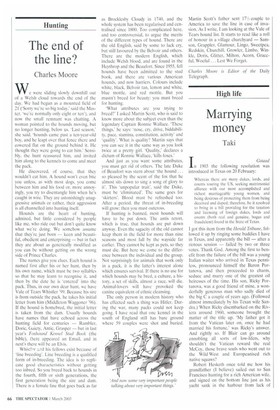The end of the line?
Charles Moore
Wc were sliding slowly downhill out of a Welsh cloud towards the end of the day. We had begun as a mounted field of 21 (`Sorry we're so big today,' said the Master, 'we're normally only eight or ten.), and now the small remnant was chatting. A woman pointed to the hounds moving, but no longer hunting, below us. 'Last season,' she said, 'hounds came past a ten-year-old boy, and he leapt over that fence there and cowered flat on the ground behind it. He thought they were going to eat him.' Sensibly, the hunt reassured him, and invited him along to the kennels to come and meet the pack.
He discovered, of course, that they wouldn't eat him. A hound won't even bite you unless, as with most dogs, you come between him and his food or, more annoyingly, you try to disentangle him when he's caught in wire. They are astonishingly unaggressive animals or rather, their aggression is all channelled into hunting itself.
Hounds are the heart of hunting, admired, but little considered by people like me, who ride out hut don't quite know what we're doing. We somehow assume that they're just born — keen and beautiful, obedient and enterprising — but in fact they are about as genetically modified as you can be without getting on the wrong side of Prince Charles.
The names give you clues. Each hound is named first after his or her hunt, then by his own name, which must be two syllables so that he may learn to recognise it, and then by the date he is 'entered' into the pack. Thus, in our own dear hunt, we have Vale of Tears Whistler '99. Because his sire is from outside the pack, he takes his initial letter from him (Middleton Waggoner '96). If the hound is homebred, the initial letter is taken from the dam. Usually hounds have names that have echoed across the hunting field for centuries — Rambler, Doric, Gaiety, Antic, Grasper — but in last year's Foxhound Kennel Stud Book (the bible), there appeared an Email, and in next's there will be an Elvis.
Whistl-r ..7:-.4:1 his fellows exist because of 'line breeding'. Line breeding is a qualified form of in-breeding. The idea is to replicate good characteristics without getting too inbred. So you breed back to hounds in the fourth, fifth or sixth generations, the first generation being the sire and dam. There is a female line that goes back as far
as Brocklesby Cloudy in 1740, and the whole system has been regularised and centralised since 1800. Too complicated here, and too controversial, to argue the merits of the different types of hound. There are the old English, said by some to lack cry, but still favoured by the Belvoir and others. There are the modern English, which include Welsh blood, and are found in the Heythrop and the Beaufort. Since 1955, fell hounds have been admitted to the stud book, and there are various American hounds, and now harriers. Colours include white, black, BeEvoir tan, lemon and white, blue mottle. and red mottle. But you mustn't breed for beauty: you must breed for hunting.
'What attributes are you trying to breed?' I asked Martin Scott, who is said to know more about the subject even than the legendary Captain Ronnie Wallace. 'These things,' he says: 'nose, cry, drive, biddability, pace, stamina, constitution, activity' and 'quality'. What is quality? Martin says that you can see it in the same way as you look twice at a pretty girl. 'Quality,' declares a dictum of Ronnie Wallace, 'kills foxes.'
And just as you want some attributes, you must get rid of others. The late Duke of Beaufort was stern about 'the hound ... so pleased by the scent of the fox that he almost sits down to sing a song of glory to it'. This 'unpopular trait', said the Duke, must be 'eliminated'. The same goes for 'skirters'. Blood must be refreshed too. After a period, the threat of in-breeding will grow: then you must outcross.
If hunting is banned, most hounds will have to he put down. The antis retort, which is true, that hounds are put down anyway. Even the sagacity of the old cannot keep them in the field for more than nine seasons and most fall by the wayside far earlier. They cannot be kept as pets, so they must die. But here we come to the difference between the individual and the group. Not surprisingly for animals that work only in a pack, it is the latter's interest alone which ensures survival. If there is no use for which hounds may be bred, a culture, a history, a set of skills, almost a race, will die. Animal-lovers will have provoked the canine equivalent of ethnic cleansing.
The only person in modern history who has effected such a thing was Hitler. During the war, many packs could not keep going. I have read that one kennel in the south of England still has bare ground where 59 couples were shot and buried.
Martin Scott's father sent 111/2 couple to America to save the line in case of invasion. As I write, I am looking at the Vale of Tears hound list. It starts to read like a roll of honour in a village churchyard — Samson, Grappler, Glamour, Lingo, Sweetpea, Redskin, Churchill, Growler, Limbo, Winkle, Doris, Glitter, Milton, Acorn, Graceful. Woeful. Lest We Forget.
Charles Moore is Editor of the Daily Telegraph.


















































































 Previous page
Previous page